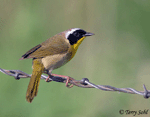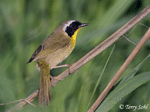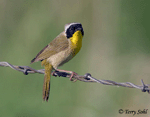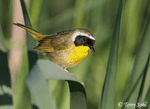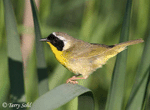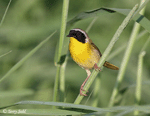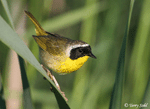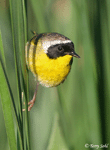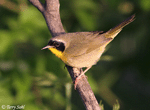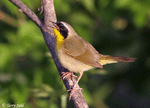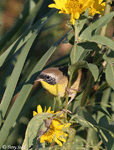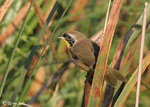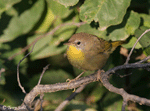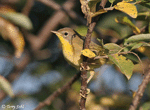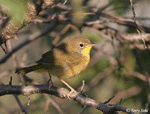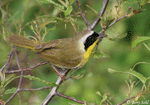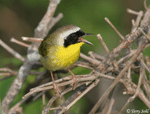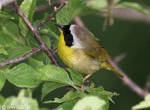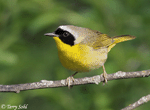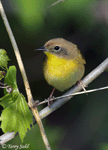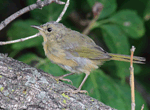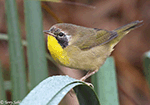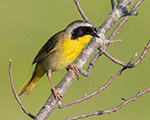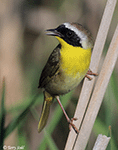| Length: 5 inches | Wingspan: 8 inches | Seasonality: Summer |
| ID Keys: Male distinctive with black mask and yellow throat and chest. | ||
 Common
Yellowthroats are one of the most widespread
and common warblers, and one of a handful that breeds in South Dakota.
They are the only warblers that nest in marshes and wetlands,
and can also be found in a wide variety of other brushy, wet habitats.
While being quite common and vocal, they can be quite difficult to spot, as they
often stay hidden amongst thick vegetation. The wich-ity wich-ity
wichity song of the Common Yellowthroat is a common sound in wetlands in
the spring and early summer. A male is pictured in the photo on the right.
Females are much less brightly marked (see additional photos at the bottom of
the page).
Common
Yellowthroats are one of the most widespread
and common warblers, and one of a handful that breeds in South Dakota.
They are the only warblers that nest in marshes and wetlands,
and can also be found in a wide variety of other brushy, wet habitats.
While being quite common and vocal, they can be quite difficult to spot, as they
often stay hidden amongst thick vegetation. The wich-ity wich-ity
wichity song of the Common Yellowthroat is a common sound in wetlands in
the spring and early summer. A male is pictured in the photo on the right.
Females are much less brightly marked (see additional photos at the bottom of
the page).
Habitat:
Prefers dense thickets near water, such has thick wetland vegetation, shrubby streamsides, and brushy wet fields
Diet:
Primarily insects and spiders. They will also occasionally feed on seeds.
Behavior:
Forages by moving through low vegetation, gleaning insects from foliage and the ground. Will also occasionally fly out from a perch to catch flying insects.
Nesting:
June and July in South Dakota. The nest of a common Yellowthroat is constructed by the female, and placed on the ground or very low to the ground in dense vegetation near a wetland or riparian area. The nest is a broad cup, constructed of grasses, strips of bark, roots, and other vegetative material, lined with finer grasses, hair, and down. The nest is also sometimes more enclosed, with an opening on the side. The female lays 3 to 6 eggs, and she alone incubates them. The young hatch after about 12 days, and fledge from the nest 10-14 days after hatching.
Song:
Common Yellowthroat males are known for their characteristic witchity-witchity-witchity song. Common Yellowthroats also have a simple chek call and more chattery scolding.
- Click here to hear the characteristic song of a male Common Yellowthroat1
- Click here to hear the short calls of a Common Yellowthroat2
- Click here to hear the chattery scolding of a Common Yellowthroat3
Migration:
Summers throughout most of the U.S. and the southern half of Canada. Winters near the Gulf and Atlantic coasts, the California coast, Mexico, and Central America.
Interactive eBird Map:
Click here to access an interactive eBird map of Common Yellowthroat sightings
Similar Species:
If seen well, males are quite distinctive. ales are quite distinctive. The less dramatically marked females (and immature males) may be confused with some other warbler species.
- Mourning Warbler - Female Common Yellowthroats share a general pattern of muted grayish (leaning to tannish) tones above and yellowish tones below. However, the Mourning Warbler has a completely gray head and throat, while the female Common Yellowthroat has a yellow throat (surprising, given the name!). Mourning Warblers have more yellow on the belly itself, while yellow on a female Common Yellowthroat is restricted to the throat region and undertail coverts.
- Nashville Warbler - Similar to the Mourning Warbler, Nashville Warblers have a more gray head, lack of yellow on the throat, and more yellow on the belly than does a female (or immature) Common Yellowthroat.
- Yellow-breasted Chat - Yellow-breasted Chat certainly shares the bright yellow throat of a Common Yellowthroat male, but they lack the black mask of a male, are quite a bit larger with a bit different structure, and have white undertail coverts compared to the yellow undertail coverts on a Common Yellowthroat.
- Orange-crowned Warbler - Immature female Common Yellowthroats are quite plain overall with subtle overall plumage markings. They thus can be confused with the often similarly plain Orange-crowned Warbler. Immature female Common Yellowthroats tend to have a more distinct line between a darker face and head and a lighter throat, while colors on an Orange-crowned Warbler are usually more uniform on the face and throat.
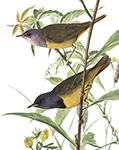 |
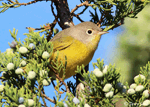 |
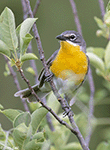 |
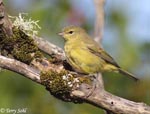 |
| Mourning Warbler | Nashville Warbler | Yellow-breasted Chat | Orange-crowned Warbler |
Conservation Status:
Widespread and common, but with local declines due to habitat loss and degradation. Overall though they are common in many areas, are found across an extremely broad geographic area, and have stable populations overall. The IUCN considers the Common Yellowthroat to be a species of "Least Concern".
Further Information:
Photo Information:
June 15th, 2008 -- Atkins Slough near Tea, Lincoln County -- Terry Sohl
Additional Photos:
Click on the image chips or text links below for additional, higher-resolution Common Yellowthroat photos.
Audio File Credits:
- 1Thomas Margarian. Audio recorded in Oregon on April 21st, 2019. Original audio file and information from xeno-canto.
- 2Manuel Grosselet. Audio recorded in Mexico on January 13th, 2020. Original audio file and information from xeno-canto.
- 3Paul Marvin. Audio recorded near San Diego, California on June 26th, 2019. Original audio file and information from xeno-canto.
| Click on the map below for a higher-resolution view |
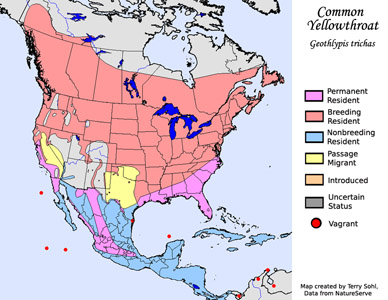 |
| South Dakota Status: Common summer breeding resident in appropriate habitat throughout the state. |
Additional Common Yellowthroat Photos
